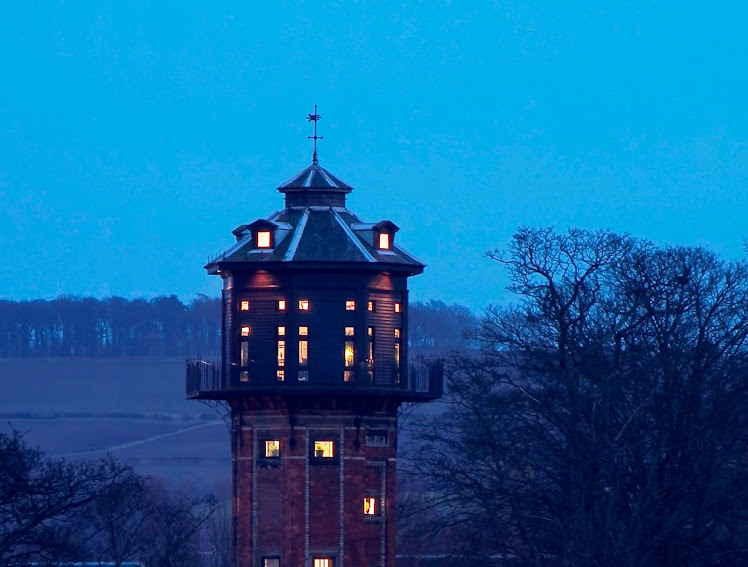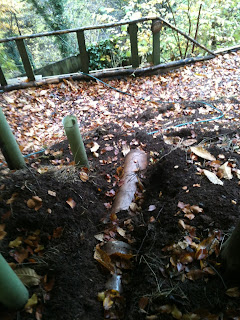Bit of a challenge at water tower wood today with a guy claiming a right of way along the top of the river bank, past our home. It wasn't a friendly intervention, not claimed in any spirit of wanting to walk it for interests sake, which I am always open to for anyone who might like to see the woodland and the views across the park. The train crossing the viaduct is also a sight to behold, I'm always willing to let people in to see this.
Re the right of way, I remember the conclusion written up by the Scottish Government reporter when our appeal was upheld in 2010. There is no right of way on our land and never has been.
There used to be a public short cut path, but it was never more than that.
Before we built our lovely home on the ground, the council had formally blocked access to this short cut path. I remember one time when our neighbours son cycled along the path and fell down the embankment. The fire service were called to rescue him.
So when someone comes onto your land, is that trespass in Scotland?
I found this useful article.
https://www.thompsons-scotland.co.uk/blog/33-main/2527-are-there-really-no-trespassing-laws-in-scotland
______________________________________________________
It is an oft-repeated myth that there are no trespassing laws in Scotland. This is simply not true. Trespass is a civil wrong, called a delict in Scots legal terminology.
The origins of civil trespassing laws in Scotland go back centuries. A court decision from 1791 in the case of Livingstone v Earl of Breadalbane states that “…every man is the proprietor of his grounds, and entitled to the exclusive possession of them… No man can claim a road or passage through another man’s property… without a servitude… for amusement of any kind, however necessary for health…”
You may think that this ancient case does not bear much relevance to modern living, but a person’s right to the full exercise of their property is protected by Protocol 1, Article 1 of the European Convention on Human Rights. Although the court decision from 1791 is old, it accurately states the law.
However, the waters were muddied by the introduction of what is commonly known as “the right to roam.” Public access rights were created by the Land Reform (Scotland) Act 2003. This Act provides the public the right to be on and cross most land and inland water in Scotland in a responsible manner. However, public access rights do not apply to the following places:
- Houses, gardens and non-residential buildings and associated land
- Land in which crops are growing
- Land next to a school and used by the school
- Sports or playing fields (where exercising access rights would interfere with their use)
- Airfields, railways, quarries, construction sites and military bases
- Visitor attractions or other places which charge for entry
For a more extensive list of places where public access rights do and do not apply, see the Scottish Outdoor Access Code.
Where a member of the public accesses land which is not covered by public access rights, they are trespassing. A court can therefore make an order to prevent trespassers from entering the land. Breach of such a court order could become a criminal offence.
However, land owners also have responsibilities. If a member of the public is injured while exercising their public access rights, the land manager or owner could be liable for injuries sustained if they did not take adequate precautions to protect those on their land.
If you have concerns about trespassing, we recommend reading the Scottish Outdoor Access Code which provides guidance to landowners and members of the public. __________________________________________________________
Here is the evidence from the Scottish Government Reporter.
Extracted from this planning application 10/00694/DPP.
Decision by M J Culshaw, a Reporter appointed by the Scottish Ministers
- Planning appeal reference: PPA-290-2014
- Site address: RP9 The Water Tower, Cemetery Road, Dalkeith, EH22 3DL
- The development proposed: Erection of timber decking with storage beneath, erection of boundary fence incorporating a bin store, works to stabilise banking, alterations to path, formation of woodland access steps and erection of associated guard rails
J - APPEAL DECISION NOTICE (REPORTER'S FINDINGS)
Section 15.
15. The council have referred to the requirement of Policy RP9 that development within the river valley protection areas of the North Esk, South Esk and Tyne rivers should have a specific locational need. Since all these works are associated with a dwelling permitted by the council within the protected area it is difficult to see how the need for them could be more locationally specific. They clearly could not be carried out anywhere else. The policy further requires that locationally necessary development should not adversely impact on the landscape or conservation value of the valleys and I have concluded that it does not. It also requires that it should not impede potential public access opportunities, but since no public right of way is claimed and this is a dwelling curtilage where rights of access under the Land Reform Act 2003 do not apply no such opportunities exist, whatever may have been the case before the dwelling was built.

Couldn't do a blog post without some before and after photos. Took a wee while to find these but we start with Year 2000 when there was a garden gazebo on the site, then the sitooterie in 2010, followed by the latest change, the potting shed in 2018.
We demolished the sitooterie and created a better path along the very steep edge of the gorge woodland. It looks much better now IMHO.
This is the path that the guy walked along yesterday. I love my path, I had to dig away a fair bit of the slope to help create it. That slope was an easy dig, the soil is akin to dust having been impacted by the blaise run off from years gone by from the tennis courts behind. Have taken the time to mulch and add planting to try to encourage root growth to aid stability.
In digging it out I exposed a pile of old bricks built as a chamber, probably an old cesspit/sewage tank in its day.
No longer in use though.
The brick structure was sitting directly above the historic landslip on this ground. I did blog about this previously in 2012. I can never work out how to do a link to a previous post so here is a copy/paste.
Planting season is here and once again I am hindered by something solid under the ground preventing access for new planting. This time I unearth an old field drain. It appears at the tennis club fence and then tracks underground a short way. It was full of soil but not carrying any water. Bone dry.
Interesting to see where this is. Above the area where the path was broadened a few years ago because the path at this corner was very narrow. Below the path is the section of the bank where there has clearly been land slip in the past. I suspect this old field drain may be part of the reason for the slip. Who knows.
Right now though the soil is dry and very easy to dig. Lots of crushed stone (blaise) in the soil which seems to aid drainage and I am told will be OK to support growth. Planting is Holly, Blackberry, Blackcurrant, Redcurrant, Horseradish, White strawberry (because the birds will not eat them!), Rhubarb and then some edge planting of ivy and fern to maintain the woodland feel. Its an area of the slope that has been bereft of plants other than self seeded grasses, weeds and a few wild flowers. The odd daffodil as well. This planting is to establish some edible woodland plants. Fingers crossed, the light levels are reasonable but it is North West facing.
The old drain pipe is now removed.
Susan Goldwyre
12th November 2012.
Update from my other half - "it can't be a field drain". There's no area to drain unless the tennis courts were cambered to that point or there was a herring bone drain system in place and there's no sign of that. More likely is that this was the septic pipe so maybe this is the pipe that served the septic tank that people tell us became blocked and took away a section of the hillside? Anyone got any more info?????
Water Tower Wood Land
Our water tower woodland ground of course was bought from the council, no doubt keen to offload the liability given they had attempted to block the short cut path, signed as "no access". But the signage and wire netting were often vandalised by those wishing to still walk here.
Not dis-similar to the situation faced by the council again now. Since Ironmills Steps were blocked 5 years ago (opening for a short period before further landslip took place). The signage and fencing keeps being added to, in an attempt to stop people walking this ground. I still go there at times, accessing from my own ground and just to make sure the landslip isn't impacting on our ground. So far, so good. All looks well.
At Ironmills Steps, there is still a water source to identify and the land is so damaged no weight bearing structures should be built onto it. A light weight set of steps may be possible I guess but that's up to the council. At the last Participation Group meeting the council agreed to add information boards to the site to let the public know what has happened and what is likely to happen next (if anything).
I may start putting up information myself if we wait too much longer, I do get a tad fed up of people asking me what's happening to the steps and whether for not I worry about our house (I usually reply we are keen for a Musselburgh Post Code).
There are much worse things in life than bit of steep river bank landslip.
Causes of Landslip?
The historic landslip on our ground which still moves, albeit very very slowly, sits below the site of historic drainage infrastructure.
The Lugton Road landslip was found to be partly caused by an enormous blocked drainage culvert.
The Ironmills Steps sit directly below some very shoddy leaking drainage works exposed in recent years when the landslip here started.
Landslip ; steep river banks - climate change - wet summers? Yes to all of these, but add drainage infrastructure or ignore at your peril.
Happy Xmas when it comes around, couple of days away. Hoping to catch up with all my lovely neighbours over New Year, despite the guy who walked the path saying all my neighbours hated me and I had been involved in Major, then maybe Minor, Corruption.
Cheers
Susan





